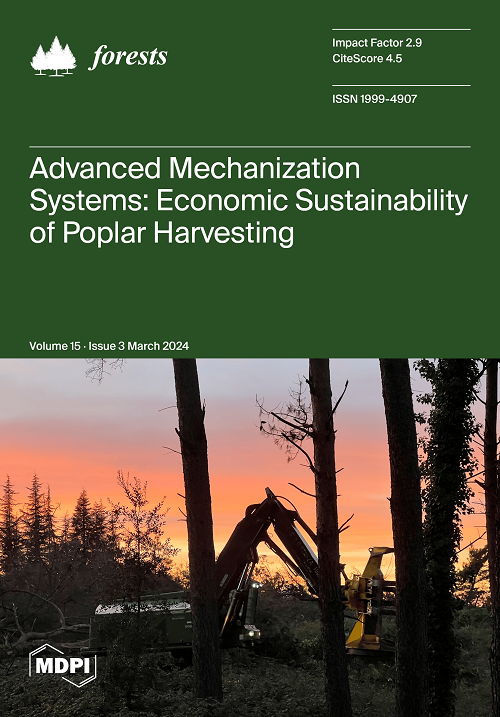利用 SFM-MVS 对干旱条件下杨树幼苗叶片叶绿素含量进行三维定量和可视化分析
IF 2.5
2区 农林科学
Q1 FORESTRY
引用次数: 0
摘要
随着全球气温升高,干旱导致植物减产,是造成植物损失最严重的非生物胁迫之一。及早识别植物干旱对提前做出改良决策具有重要意义。叶绿素与植物的光合作用和营养状况密切相关。通过跟踪植物品系间叶绿素的变化,可以识别干旱对植物生理状态的影响,有效调整植物对生态系统的适应性,实现种植管理策略和资源利用效率的优化。植物三维重建和三维特征描述是当前表型组学发展的研究热点,可立体揭示干旱对植物结构和生理表型的影响。本文获取了四个杨树品种在干旱前后的可见光多视角图像。利用机器学习算法建立了彩色植被指数与叶绿素含量之间的回归模型。基于偏最小二乘回归(PLSR)的模型性能最佳,R2 为 0.711。SFM-MVS 算法用于重建植物的三维点云,并进行颜色校正、点云降噪和形态校准。将训练好的 PLSR 叶绿素预测模型与点云颜色信息相结合,重新渲染点云颜色,实现植物叶绿素含量的三维数字化。实验研究发现,在自然生长条件下,杨树的叶绿素含量呈梯度分布状态,含量值从上到下逐渐增加。与胁迫前相比,叶绿素含量有所提高,但不再呈梯度分布状态。同时,严重干旱胁迫后,叶绿素值整体下降,下部叶片开始变黄、萎蔫、脱落;当胁迫强度与持续时间一致时,干旱对叶绿素值的影响为 895 < -SY-1 < 110 < 3804。这项研究为深入了解植物对环境胁迫的机理和生理反应提供了有效工具。对提高农林业生产水平、保护生态环境具有重要意义。同时也为解决全球气候变化引起的植物干旱问题提供了决策依据。本文章由计算机程序翻译,如有差异,请以英文原文为准。
Three-Dimensional Quantification and Visualization of Leaf Chlorophyll Content in Poplar Saplings under Drought Using SFM-MVS
As global temperatures warm, drought reduces plant yields and is one of the most serious abiotic stresses causing plant losses. The early identification of plant drought is of great significance for making improvement decisions in advance. Chlorophyll is closely related to plant photosynthesis and nutritional status. By tracking the changes in chlorophyll between plant strains, we can identify the impact of drought on a plant’s physiological status, efficiently adjust the plant’s ecosystem adaptability, and achieve optimization of planting management strategies and resource utilization efficiency. Plant three-dimensional reconstruction and three-dimensional character description are current research hot spots in the development of phenomics, which can three-dimensionally reveal the impact of drought on plant structure and physiological phenotypes. This article obtains visible light multi-view images of four poplar varieties before and after drought. Machine learning algorithms were used to establish the regression models between color vegetation indices and chlorophyll content. The model, based on the partial least squares regression (PLSR), reached the best performance, with an R2 of 0.711. The SFM-MVS algorithm was used to reconstruct the plant’s three-dimensional point cloud and perform color correction, point cloud noise reduction, and morphological calibration. The trained PLSR chlorophyll prediction model was combined with the point cloud color information, and the point cloud color was re-rendered to achieve three-dimensional digitization of plant chlorophyll content. Experimental research found that under natural growth conditions, the chlorophyll content of poplar trees showed a gradient distribution state with gradually increasing values from top to bottom; after being given a short period of mild drought stress, the chlorophyll content accumulated. Compared with the value before stress, it has improved, but no longer presents a gradient distribution state. At the same time, after severe drought stress, the chlorophyll value decreased as a whole, and the lower leaves began to turn yellow, wilt and fall off; when the stress intensity was consistent with the duration, the effect of drought on the chlorophyll value was 895 < -SY-1 < 110 < 3804. This research provides an effective tool for in-depth understanding of the mechanisms and physiological responses of plants to environmental stress. It is of great significance for improving agricultural and forestry production and protecting the ecological environment. It also provides decision-making for solving plant drought problems caused by global climate change.
求助全文
通过发布文献求助,成功后即可免费获取论文全文。
去求助
来源期刊

Forests
FORESTRY-
CiteScore
4.40
自引率
17.20%
发文量
1823
审稿时长
19.02 days
期刊介绍:
Forests (ISSN 1999-4907) is an international and cross-disciplinary scholarly journal of forestry and forest ecology. It publishes research papers, short communications and review papers. There is no restriction on the length of the papers. Our aim is to encourage scientists to publish their experimental and theoretical research in as much detail as possible. Full experimental and/or methodical details must be provided for research articles.
 求助内容:
求助内容: 应助结果提醒方式:
应助结果提醒方式:


